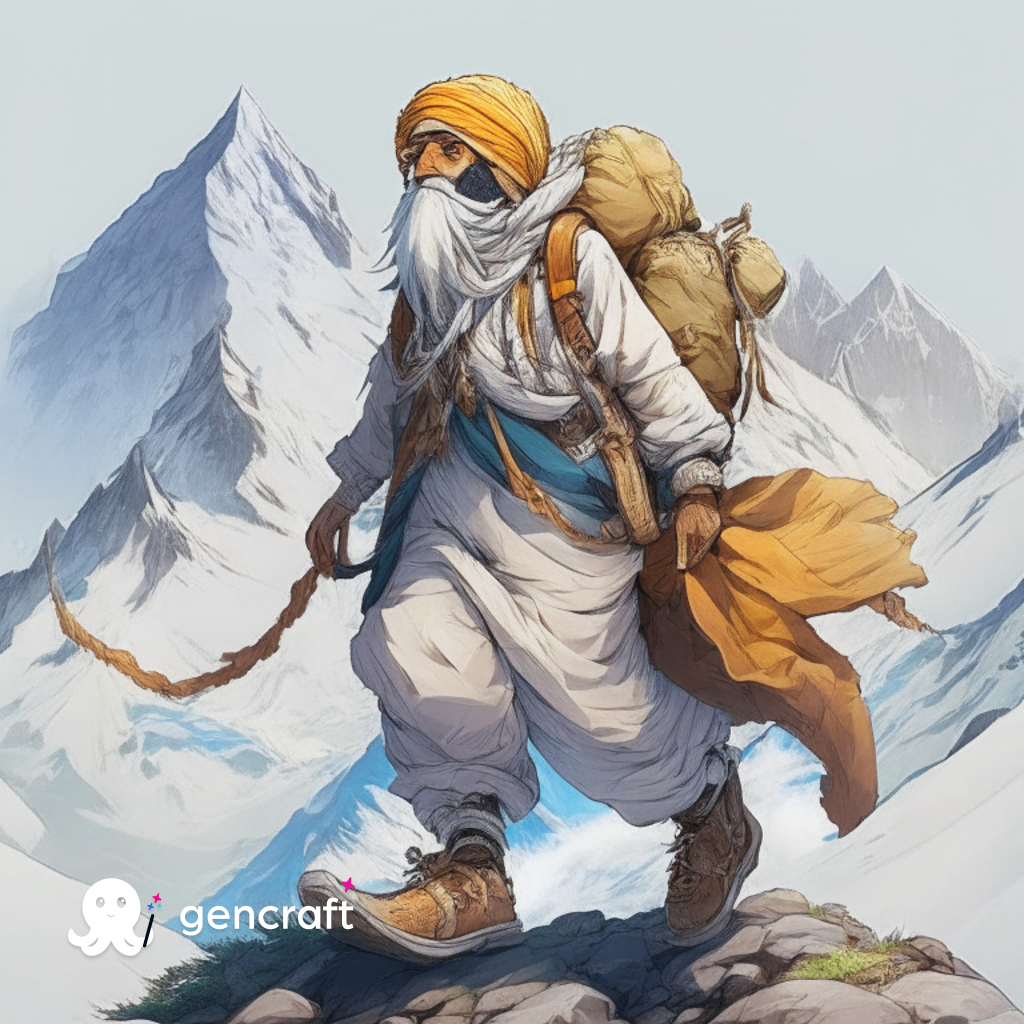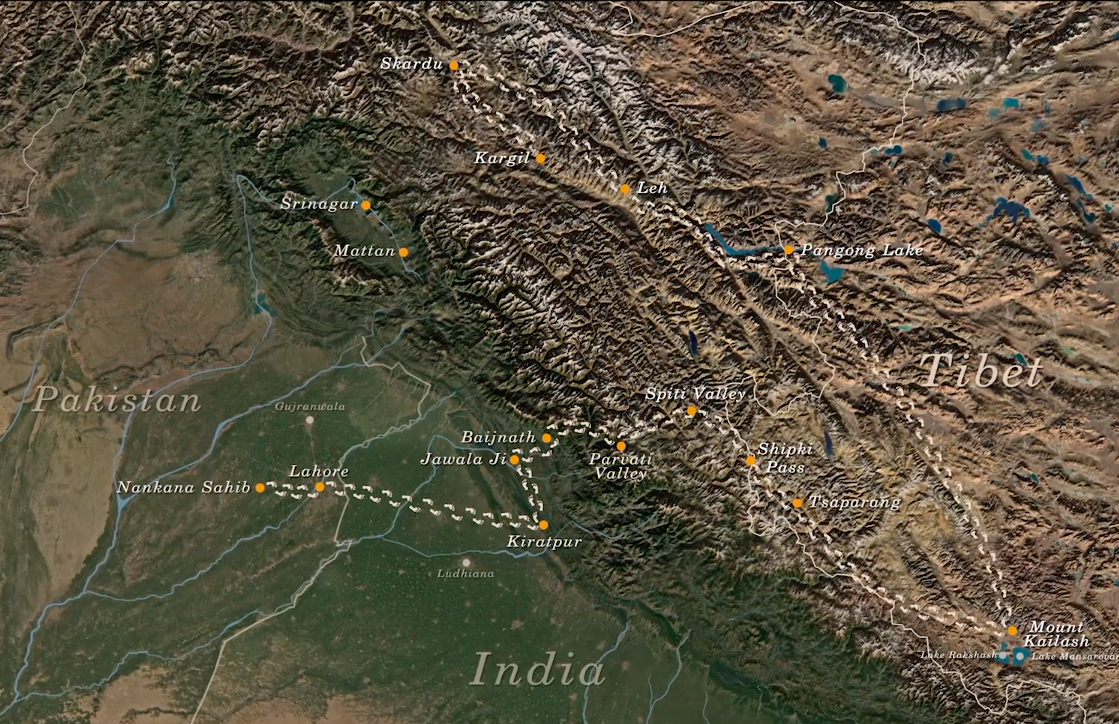
Subscribe to Trek Library and access premium content, free.
Background
25 kms from Leh lies Gurdwara Pathar Sahib. My team (Mountain Men) and I went to seek blessings on our way to Kang Yatse II expedition in 2022. After a successful return, I asked my brother from another mother Sam to accompany me back to the Gurdwara to express our gratitude.
It was here that I saw a map that blew my mind. The video shows my awe.
From 1500 - 1524 Guru Nanak travelled more than 28000 km on foot. Read that again. After the famous Arabian explorer Ibn Battuta, Guru Nanak is considered to be the second most travelled human.
All his travels were on foot. To me, he is the greatest trekker who ever lived.
After returning home, I kept thinking about the map. I ordered books, streamed documentaries, read articles and contacted experts. I became obsessed. If I was in my 20's I believe I would have gone to trace his footsteps.
His travels are split between 5 Udasis (journeys). I will stick to the third Udasi where he travelled northeast from Pakistan to India to Tibet to China and back. The highlight of this journey was his visit to Mount Sumeru, present day Mount Kailash. He was accompanied by his childhood friend, Bhai Mardana.
The expedition details below are stitched together from various resources I have mentioned in the end. It is also sprinkled with my imagination here and there.

Duration
4 years (1514 - 1518)
Difficulty Level
Beyond our imagination. I can't fathom being on foot for four months, let alone four years.
Gear
There were no weather forecasts available or documentation on the type of terrain to expect. Guru Nanak and his trek partner Bhai Mardana dressed differently for their long journey ahead based on the stories they had heard from travelers coming from the West.
They wore leather on their feet and head, carried a rope on their body.
Even if they had detailed descriptions of what to expect there weren't many gear or accessories options available in the 15th Century.
Inclusions
Pain, suffering, meeting new people, seeing new countries and cultures.
Exclusions
Guide, kitchen crew, support team, ration, tent, toilet tent, wi-fi, hot water.
Detailed Itinerary
Note: Gurdwaras mentioned below were built by followers of Guru Nanak hundreds of years after he passed away to commemorate his visit to that location.
1. Journey begins from Nankana Sahib and the first stop on the journey is Lahore, Pakistan. Situated near the river Ravi, both trekkers spent several nights camped by the river side. Gurdwara Duni Chand, Lahore, Punjab, Pakistan
2. From Lahore the duo traveled to Kiratpur. To get to their next destination they would need to cross the river Sutlej. Gurdwara Charan Kamal, Kiratpur, Punjab, India
3. Their next stop is near the foothills of Dhauladhar mountain range at a small town called Baijnath. But first they would have to cross the densely forested Sivalik Ranges. 50 km from present day Dharamsala, Baijnath used to be a famous trade route between Kashmir and Tibet.
4. They left Baijnath and headed towards a settlement in Manikaran, the famous Parvati River Valley. They traversed the Chandrakhani Pass and made their way down to the village of Malana, home to an ancient community. Gurdwara Manikaran Sahib, Parvati Valley, Himachal Pradesh, India.
If you have done the Pin Parvati Pass trek, try imagine two men without any gear, food, shelter walking next to the gushing Parvati river. Slippery rock facade, muddy terrain, unpredictable weather and narrow trails. We complain about broken bridges, at that time there were no bridges!
5. The trekking duo with no guide or support team crosses the glacier and enters Spiti Valley, crosses Shipki Pass and walks for days to reach Tsaparang in Guge Kingdom, Tibet.
6. Finally they reach Mt. Sumeru. 'Meru' represents the center of the metaphysical universe and 'Su' means supreme. Asia's four main rivers originate from Mt Kailash - Brahmaputra, Sutlej, Indus and Karnali.
My estimate is that from Nankana Sahib, Pakistan to Mt. Sumeru, Tibet the distance travelled on foot must be 2500 km. They were not done, yet.
7. Guru Nanak and his trusted partner Bhai Mardana made their way back passing Mansarovar lake, heading north to Pangong Tso and enter Leh. Gurdwara Pathar Sahib, Leh
8. From there they followed the Indus river and travelled to Skardu, Kargil, Srinagar and Mattan. Abandoned Gurdwara, Skardu Gurdwara Charan Kamal Sahib, Kargil, Ladakh, Mattan Sahib Gurdwara, J&K
The 1500 days expedition took them over passes, summits, valleys, rivers that we might not be able to see in one lifetime. My estimate is that they walked over 5000 km in these 4 years.
My short 6 months reading about Guru Nanak and his adventures has further strengthened my belief that nature has answers to all that we seek & that all doors lead to ONE.
References
Allegory: A Tapestry Of Guru Nanak's Travels, Episode 18
The Book Of Nanak - Navtej Sarna
Path Of The Guru
The Guru And His Travels
Guru Nanak : The Eternal Traveller
Panjab Digital Library
Subscribe to Trek Library and access premium content, free.
